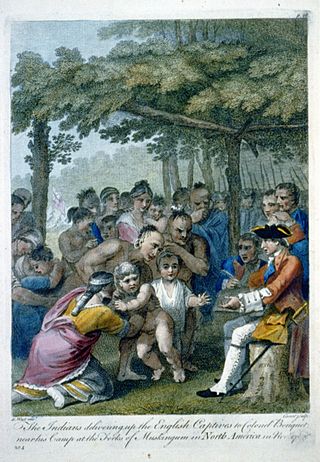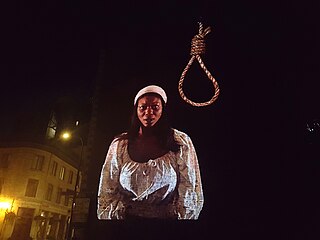Related Research Articles

The Pawnee are a Central Plains Indian tribe that historically lived in Nebraska and northern Kansas but today are based in Oklahoma. They are the federally recognized Pawnee Nation of Oklahoma, who are headquartered in Pawnee, Oklahoma. Their Pawnee language belongs to the Caddoan language family, and their name for themselves is Chatiks si chatiks or "Men of Men".

Slavery in the colonial history of the United States refers to the institution of slavery as it existed in the European colonies which eventually became part of the United States. In these colonies, slavery developed due to a combination of factors, primarily the labour demands for establishing and maintaining European colonies, which had resulted in the Atlantic slave trade. Slavery existed in every European colony in the Americas during the early modern period, and both Africans and indigenous peoples were victims of enslavement by European colonizers during the era.

Slavery in Canada includes historical practices of enslavement practiced by both the First Nations during the pre-Columbian era, and by colonists during the period of European colonization.
Black Indians are Native American people – defined as Native American due to being affiliated with Native American communities and being culturally Native American – who also have significant African American heritage.
Genízaros was the name for detribalized Native Americans (Indians) from the 17th to 19th century in the Spanish colony of New Mexico and neighboring regions of the American southwest. Genízaros were usually women and children who had been captured in war by the Spanish or purchased from Indian tribes who had held them captive as slaves. To circumvent Spanish laws forbidding slavery, the purchaser of a genízaro had the obligation to introduce them to Christianity and Spanish customs. Genízaros worked as indentured servants, shepherds, and laborers. They occupied the lowest rung of status-conscious Spanish society in New Mexico but slowly assimilated and intermarried into Spanish and later Mexican (1821-1846) and American society. The descendants of genízaros are also called genízaros and the word has become a term of pride for the descendants of the original Indian captives and slaves. In 1793, genízaros are estimated to have comprised up to one third of the 29,041 people living under Spanish rule in New Mexico.
John Askin (1739–1815) was an Anglo-Irish fur trader, merchant, and colonial official. He was instrumental in the establishment of British rule in Upper Canada.

The history of slavery spans many cultures, nationalities, and religions from ancient times to the present day. Likewise, its victims have come from many different ethnicities and religious groups. The social, economic, and legal positions of enslaved people have differed vastly in different systems of slavery in different times and places.

The Choctaw freedmen are former enslaved African Americans who were emancipated and granted citizenship in the Choctaw Nation after the Civil War, according to the tribe's new peace treaty with the United States. The term also applies to their contemporary descendants.

Captives in American Indian Wars could expect to be treated differently depending on the identity of their captors and the conflict they were involved in. During the American Indian Wars, indigenous peoples and European colonists alike frequently became captives of hostile parties. Depending on the specific instances in which they were captured, they could either be held as prisoners of war, abducted as a means of hostage diplomacy, used as countervalue targets, enslaved, or apprehended for purposes of criminal justice.

Slavery among Native Americans in the United States includes slavery by and slavery of Native Americans roughly within what is currently the United States of America.

Slavery in New France was practiced by some of the indigenous populations, which enslaved outsiders as captives in warfare, until European colonization that made commercial chattel slavery become common in New France. By 1750, two-thirds of the enslaved peoples in New France were indigenous, and by 1834, most enslaved people were black.
The Mohawk Nation reserve of Kahnawake, south of Montreal, Quebec, Canada, includes residents with surnames of Mohawk, French, Scots and English ancestry, reflecting its multicultural history. This included the adoption of European children into the community, as well as intermarriage with local colonial settlers over the life of the early village. Located along the St. Lawrence River south of the city of Montréal on the shores of the St-Louis rapids, it dates to 1667 as a Jesuit settlement called Mission Saint-François-Xavier du Sault-Saint-Louis. The original mission was located in what is now La Prairie and was called Kentake by its first Oneida settlers.
Claude Charles du Tisné led the first official French expedition to visit the Osage and the Wichita Indians in 1719 in what became known as Kansas in the present-day United States.

Slavery among the Indigenous peoples of the Americas refers to slavery of and by the Indigenous peoples of the Americas. The history of slavery spans all regions of the world; during the pre-Columbian era, many societies in the Americas enslaved prisoners of war or instituted systems of forced labor. Contact with Europeans transformed these practices, as the Spanish introduced chattel slavery through warfare and the cooption of existing systems. A number of other European powers followed suit, and from the 15th through the 19th centuries, between two and five million Indigenous people were enslaved, which had a devastating impact on many Indigenous societies, contributing to the overwhelming population decline of Indigenous peoples in the Americas.

The Skidi is one of four bands of Pawnee people, a central Plains tribe. They lived on the Central Plains of Nebraska and Kansas for most of the millennium prior to European contact. The Skidi, also known as the Wolf band lived in the northern part of Pawnee territory.
The Raudot Ordinance of 1709 was a law in the French colony of New France that legalized slavery.
The History of slavery in Michigan includes the pro-slavery and anti-slavery efforts of the state's residents prior to the ratification of the Thirteenth Amendment to the United States Constitution in 1865.
Slavery in New Mexico existed among the Native American (Indian) tribes prior to the arrival of the first Europeans. In 1542, the Spanish king banned the enslavement of the Indians of the Americas in Spanish colonies, but the ban was mostly ineffective. The enslavement of Indians was common during the Spanish exploration and colonization of New Mexico from 1540 to 1821. Slaves of the Spanish included a few of the Pueblos living in the Spanish colony, but most slaves were captured from other Indian tribes in the region. Women were more valued than men as slaves. Slaves were not only valued for their labour, but were also a prestige item among the more prominent and prosperous of the Spanish colonists. Enslavement of an individual was not always permanent. Slaves, especially women, often gained kinship relationships with their owners. The offspring and descendants of enslaved persons were called genizaros and made up one-third of New Mexico's population in the early 19th centuries. In the Spanish caste system genizaros had low status, but were important for frontier defense and cultural contacts with Indian tribes. Forced labor and debt peonage were also features of slavery in New Mexico. Some Indians captured and enslaved in New Mexico were sent south to work in Mexican mines or even to distant places like Cuba to work on sugar plantations.

Native American slave ownership refers to the ownership of enslaved Africans and Native Americans by Native Americans from the colonial period to the American Civil War. Waves of European colonization brought enslaved Africans to North America. Following this development many indigenous tribes began to acquire Africans as slaves. Many prominent people from the "Five Civilized Tribes" purchased slaves from their white neighbors and became members of the planter class.
Monette, also known as Manette, was a Native American enslaved woman of John Askin. She gave birth to three children who were educated and married into prominent families of the Great Lakes regions of present-day Michigan and Ontario, Canada. Her son was John Askin Jr. Daughter Catherine married Captain Samuel Robertson, who operated one of Askin's boats, and was married a second time to Robert Hamilton, founder of Queenston, Ontario. Daughter Madeline was married to Dr. Robert Richardson, the surgeon of the Queen's Rangers stationed at Fort George.
References
- 1 2 3 "Population: Slavery". Canadian Museum of History . Archived from the original on 2019-03-24. Retrieved 2019-06-15.
In Canada, the majority of slaves were not of African, but rather of Aboriginal origin. Native populations customarily subjugated war captives before the arrival of the French, but this practice acquired new meanings and unprecedented proportions in the context of western expansion. Beginning in the 1670s, the French began to receive captives from their Aboriginal partners as tokens of friendship during commercial and diplomatic exchanges. The Illinois were notorious for the raids which they led against nations to the southeast and from which they brought back captives. By the early eighteenth century, the practice of buying and selling these captives like merchandise was established.
- ↑ Robert Everett-Green (2014-02-28). "200 years a slave: the dark history of captivity in Canada". The Globe and Mail . Archived from the original on 2019-06-15. Retrieved 2019-06-15.
Many in Quebec had to be content with captives stolen or bought from indigenous peoples, some of whom practiced slavery before the Europeans arrived. About two-thirds of the slaves in Quebec were native people, mostly from the Pawnee nations of modern-day Nebraska, whose French Canadian name – Panis – became a synonym for an indigenous slave of any origin.
- ↑ Signa A. Daum Shanks (2013). "A Story of Marguerite: A Tale about Panis, Case Comment, and Social History". Native Studies Review . Vol. 22, no. 1. Retrieved 2019-06-15.
As typically experienced by other slaves in the New World, panis were not considered persons with respect to legal rights, but they could still be evaluated under the law in criminal matters.
- ↑ George E. Hyde (1988). The Pawnee Indians. University of Oklahoma Press. p. 24. ISBN 9780806120942 . Retrieved 2019-06-15.
The raiders carried off such great numbers of Pawnees into slavery that in the country on and east of the upper Mississippi the name Pani developed a new meaning: slave. The French adopted this meaning, and Indian slaves, no matter from which tribe they had been taken, were presently being termed Panis.
- ↑ Woodson, Carter Godwin; Logan, Rayford Whittingham (1920). The Journal of Negro History. Association for the Study of Negro Life and History.
- 1 2 Hyde, George E. (1974). The Pawnee Indians. Internet Archive. Norman : University of Oklahoma Press. ISBN 9780806110653.
- 1 2 3 4 5 6 7 8 9 10 Lawrence, Bonita (8 May 2020). "Enslavement of Indigenous People in Canada". The Canadian Encyclopedia. Historica Canada. Retrieved 6 August 2020.
- ↑ Trudel, Marcel (1960). L 'esclavage au Canada français. Les presses universitaires Laval, p. 77.
- ↑ Trudel, Marcel; d'Allaire, Micheline (2013) [1963]. Canada's Forgotten Slaves. Translated by George Tombs. Véhicule Press. p. 64.
- ↑ Beasley, David R. (2004). The Canadian Don Quixote: The Life and Works of Major John Richardson, Canada's First Novelist. David Beasley. pp. 1–2. ISBN 978-0-915317-18-9.